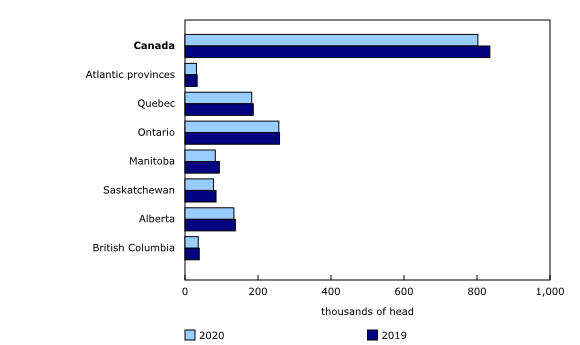Livestock estimates, January 1, 2020
Archived Content
Information identified as archived is provided for reference, research or recordkeeping purposes. It is not subject to the Government of Canada Web Standards and has not been altered or updated since it was archived. Please "contact us" to request a format other than those available.
Released: 2020-02-25
Canadian cattle, hog and sheep inventories were all down on January 1, 2020, compared with January 1, 2019.
With the exception of slight increases in 2012, 2013 and 2018, Canadian cattle inventories have declined year over year since January 2005. The decline of Canadian hog inventories marks the second consecutive year-over-year (January to January) decrease. Sheep inventories have been declining year over year since January 1, 2013, with the exception of small increases in January 2018 and 2019.
On June 25, 2019, all Canadian beef and pork product exports to China, the third-largest export destination for Canadian pork, were suspended. However, despite this suspension, strong demand from Japan, the United States and several other countries for Canadian beef and pork products offset any negative impact on the total quantity of Canadian beef and pork products exported or on the Canadian livestock industry as a whole. In early November 2019, the suspension of beef and pork product exports to China was lifted and exports to China resumed.
Cattle
Canadian farmers had 11.2 million cattle on their farms on January 1, 2020, down 1.9% from January 1, 2019, continuing the decline in the Canadian cattle herd. Inventories were 24.8% below the peak they reached in January 2005.
Alberta had the largest cattle inventories among the provinces on January 1, 2020, contributing 40.2% to the Canadian total. Saskatchewan (19.6%) and Ontario (14.1%) were the next largest contributors to the Canadian cattle inventory total.
Cattle producers retained less breeding stock in 2019, as the number of beef heifers held for breeding on Canadian farms was down 6.3% year over year to 515,000 head on January 1, 2020. The number of beef cows decreased 2.6% to 3.6 million head, while the number of feeder heifers was down 1.9% and the number of steers declined 7.1%. However, the inventory of calves edged up 0.2% to 3.7 million.
As of January 1, 72,700 farms reported inventories of cattle and calves, down 0.4% from January 1, 2019, and down 1.3% from the same date in 2018. Canadian farmers had 1.4 million dairy cows and heifers on their farms, up 0.7% from January 1, 2019.
Total disposition of cattle and calves rose 1.4% from the same date in 2018, driven by increased cattle exports, while slaughter declined during the second half of 2019, coinciding with a lower slaughter price. Total cattle slaughter decreased 0.4% to 1.8 million head over this period. However, this was the fourth consecutive annual increase for total slaughter. International cattle exports increased 6.9% to 309,400 head during the second half of 2019, compared with the same period in 2018.
Prices for slaughter cattle and calves continued to decline in 2019 from the peak levels of 2015.
Hogs
Hog producers reported 13.9 million hogs on January 1, 2020, down 0.6% from January 1, 2019. This was the second consecutive year-over-year decrease. However, the hog inventory remained 11.3% above the level from a decade earlier.
Quebec had the largest hog inventories among the provinces on January 1, accounting for close to one-third of the Canadian total. Quebec, Ontario and Manitoba together represented over 80% of total Canadian hog inventories.
As of January 1, 7,650 farms reported hogs in Canada, down 0.6% from the same date a year earlier. These farms reported 1.2 million sows and gilts, down 0.7%.
Canada exported 2.5 million hogs in the second half of 2019, down 1.4% from the same period in 2018. Lower exports were partly attributable to high levels of hog inventories in the United States—the 2019 United States pig crop was the largest since 1970. Canada exported 5.1 million hogs in 2019, down 2.8% from 2018 and down 49.0% from the 2007 export peak.
Hog slaughter increased in Canada in the last six months of 2019, up 2.4% from the same period in 2018 to 11.0 million head, coinciding with an increase in the July-to-December average price of Canadian slaughter hogs in 2019. Strong pork demand from several countries, mainly Japan, offset any negative effects from the suspension of exports to China and may have contributed to the price increase of slaughter hogs and the greater number of hogs slaughtered in Canada.
The July-to-December 2019 pig crop was 14.2 million head, up 1.2% from the same period in 2018.
Sheep
The inventories of sheep and lambs on January 1, 2020, were down 4.0% to 802,300 head from January 1, 2019. Inventories were 19.3% below their highest level recorded in January 2004.
Ontario and Quebec together represented just over half of total sheep and lamb inventories on January 1.
The sheep breeding herd decreased, as the number of ewes declined 4.7% to 491,300 head, replacement lambs fell 5.5% to 74,900 head, and rams were down by 0.9% to 23,300 head. The number of market lambs declined 2.0% to 212,800 head, compared with January 1, 2019.
International exports of sheep rose to 7,500 head in the last six months of 2019, the highest level since the first half of 2016.
The July-to-December average price of Canadian slaughter lambs was lower in 2019 compared with the same period in 2018.
Note to readers
Livestock estimates are available for Canada and the provinces, as well as for the United States.
Products
The Agriculture and food statistics portal, accessible from the Subjects module of our website, provides users a single point of access to a wide variety of information related to agriculture and food.
Contact information
For more information, or to enquire about the concepts, methods or data quality of this release, contact us (toll-free 1-800-263-1136; 514-283-8300; STATCAN.infostats-infostats.STATCAN@canada.ca) or Media Relations (613-951-4636; STATCAN.mediahotline-ligneinfomedias.STATCAN@canada.ca).
- Date modified:





